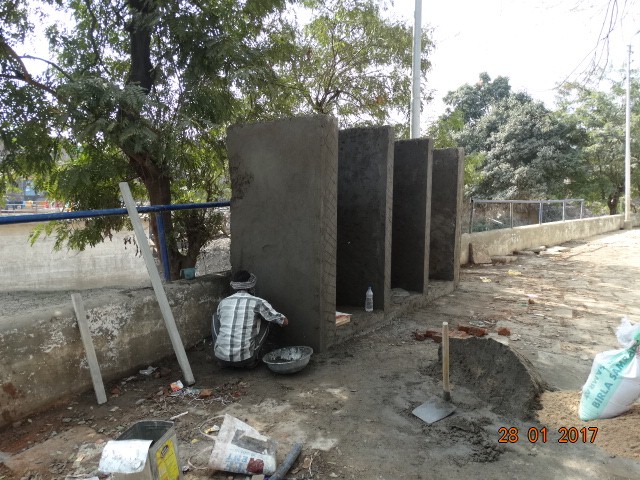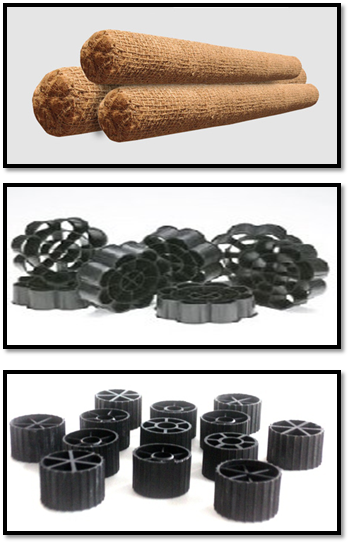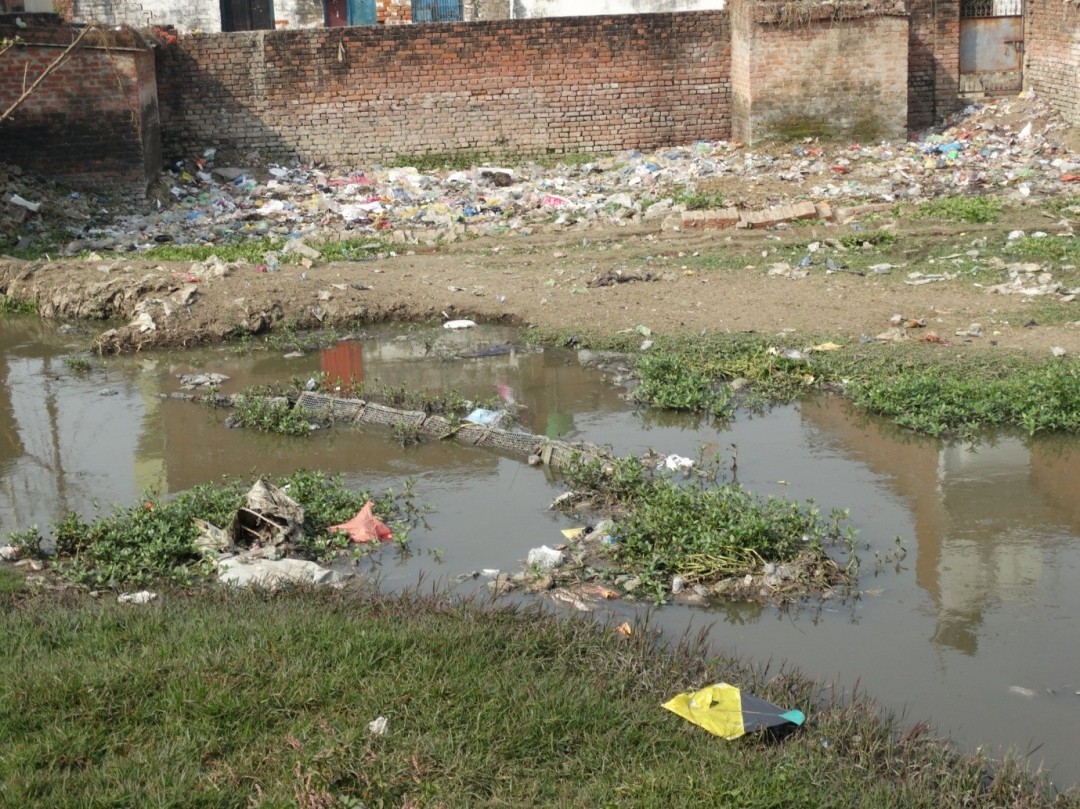Bacterial Bioremediation for Ganga Pollution With Community Knowledge for Coconut Coir
Based
on its experience in Delhi and Agra INTACH has initiated a one month
pilot project for cleaning wastewater flow in Assi Nadi using the
process of bacterial bioremediation.
Coir:
Byproducts/Waste :
By weight, coir fibers account for about one-third of the coconut pulp.
The other two-thirds, the coir pith (also known as coir dust), has
generally been considered a useless waste material. Although it is
biodegradable, it takes 20 years to decompose. Millions of tons sit in
huge piles in India and Sri Lanka. During the last half of the 1980s,
researchers successfully developed processes to transform coir pith into a
mulching, soil treatment, and hydroponic (without soil) growth medium that
is used as an alternative to such materials as peat moss and
vermiculite.
Before being compressed into briquettes for sale, the coir pith is
partially decomposed through the action of certain microbes and fungi. An
Australian company has also recently begun turning coir pith into an
absorbent product used to remediate oil spills.
The retting process used in coir fiber production generates significant
water pollution. Among the major organic pollutants are pectin, pectosan,
fat, tannin, toxic polyphenols, and several types of bacteria including
salmonella. Scientists are experimenting with treatment options, and at
least one coir manufacturing company claims to be treating its effluent
water.
INTACH pilot project reduces Assi River Pollution in Varanasi by 70% in two months, at least cost, without any structure.
Page no. 17, 18, Virasat /January - March 201
Link Here : http://www.intach.org/pdf/virasat-jan-mar.pdf
official site : http://www.intach.org/
REPORT TO DIVISIONAL COMMISSIONER, VARANASI
On INTACH’s Pilot Project on Assi Nadi [24th Jan/17 – 26th Feb/17]
On INTACH’s Pilot Project on Assi Nadi [24th Jan/17 – 26th Feb/17]
Guest Blog by Manu Bhatnagar, INTACH
source: sandrp.wordpress.com
for link: more
- INTACH is a national non-profit organization, a registered society under Society’s Act since 1984, having the Secretaries of the GoI Ministries of Environment, Forest & Ganga Rejuvenation, Ministry of Urban Development, Ministry of Culture, DG [ASI] and DG [NM] on its Governing Council with its accounts duly audited by the Office of CAG.
- High pollution load in holy River Ganga at Varanasi is due to domestic wastewater flowing into the river through 33 nallahs and rivulets. Sewerage systems and treatment plants are going to take several years to be in place and effective. In the meantime the river will continue to remain polluted. Based on its experience in Delhi and Agra INTACH has initiated a one month pilot project for cleaning wastewater flow in Assi Nadi using the process of bacterial bioremediation.
3.0 INTACH, as a conscious institutional
citizen, initiated a pilot project at its own cost, to reduce pollution
in Assi Nadi using low cost unconventional technology. In obedience to
directions of Hon’ble High Court, Allahabad, the Director, NMCG,
constituted a committee under chairmanship of Commissioner, Varanasi
Division for carrying out various improvements related to the Ganga
river, which Committee vide its minutes of meeting of 13th June, 2016
and subsequent minutes of meeting dated 19/9/16 granted an NOC to INTACH
to carry out a pilot project of pollution abatement of Assi Nadi at its
own cost subject to approval by the Committee’s environmental expert,
Prof. UK Choudhary, which approval was granted by the learned professor
on 28th Oct/2016 after a detailed explanation by INTACH of
the proposed process and activities. Subsequently, INTACH mobilized its
resources during December, 2016 and implemented the pre-project
preparations by 23rd January, 2017.
4.0 The Assi Nadi is some 3.5 km long and meanders through some very densely populated built up areas directly discharging wastewater into the Nadi. All along there has been severe encroachment of the Nadi bed and channel and in the absence of adequate solid waste collection much garbage [including carcasses find their way into the Nadi] The discharge in the Nadi was measured on 3 days for 24 hours each and amounted to 66 MLD [probably 70 MLD as some flow was bypassing the V –Notch]. The water is fast flowing owing to the elevation difference of 27m between origin and river level.

Encroachments and Garbage Dumping (Photo: INTACH)

Floating Garbage Adding To Pollution And poor Aesthetics (Photo: INTACH)
5.0 Several tests of water quality were carried out before start of treatment:

Hourly Flow Measurement Over 24 Hours [2 Days Consecutively]
6.0 Challenges : There were several challenges to be overcome as follows :


4.0 The Assi Nadi is some 3.5 km long and meanders through some very densely populated built up areas directly discharging wastewater into the Nadi. All along there has been severe encroachment of the Nadi bed and channel and in the absence of adequate solid waste collection much garbage [including carcasses find their way into the Nadi] The discharge in the Nadi was measured on 3 days for 24 hours each and amounted to 66 MLD [probably 70 MLD as some flow was bypassing the V –Notch]. The water is fast flowing owing to the elevation difference of 27m between origin and river level.

Encroachments and Garbage Dumping (Photo: INTACH)

Floating Garbage Adding To Pollution And poor Aesthetics (Photo: INTACH)
5.0 Several tests of water quality were carried out before start of treatment:
| Sl. No. | Parameter mg/ltr | Near Confluence Point 5/15 of Ganga |
Near Confluence Point 12/16 of Ganga |
| 1. | BOD | 160 | 185 |
| 2. | COD | 436.4 | 240 |
| 3. | TSS | 422 | 196 |
| 4. | Sulphide | 2 | – |
| 5. | DO | 0.1 | – |
| 6. | Phosphate ( as PO4) | 6.2 | – |
| 7. | Nitrate (NO4) | 4 | – |
| 8. | Turbidity NTU | 20 | – |

Hourly Flow Measurement Over 24 Hours [2 Days Consecutively]
6.0 Challenges : There were several challenges to be overcome as follows :
- Severe floating garbage disposition
- High velocity of flow giving little retention time for treatment
- Close encroachments on active channel land causing encroaching public to resist interventions which raise water levels
- Several inflows even in the last 300m before river outfall which are difficult to treat in short stretch

Sewage Leaking From Sulabh Shauchalaya [Note Another Inflow At Bottom of Image]

New Toilets Discharge Directly Into Assi (Photo: INTACH)
7.0 Proposed Solution : To overcome the challenges several interventions were planned and implemented as follows :

8.0 Why Bioremediation :





9.0 Operations : The work of installing the interventions commenced in the last week of December, 2016 and was completed by 23 January, 2017. On 24th January, 2017 the bacteria concentrate dozing was commenced.




10. Even as early as 28th Jauary, 2017 residents along the Nadi reported substantial reduction in foul odour [interview with basti pradhan recorded] and their relief from the same and their positive impression of water quality improvement. Regular bathers at Assi Ghat also vouched for a palpable improvement in water quality.





11. Water Testing : Testing was carried out in December, 2017 before start of work and the results are as follows :
- Bioremediation methods would be adopted – bioremediation is the process of removal of pollutants from polluted water (basically organic in nature) with the help of biological products
- Introduction of bacteria concentrates [a precisely balanced blend of naturally occurring, strictly Anaerobic & Facultative live bacterial strains that start dispersing immediately on dilution with water] @ of 100 litres of concentrate per day dozed into the stream at 6 carefully selected locations. The bacteria degrades organic pollutants, enhances dissolved oxygen levels, removes odours.
- Increase retention time by installing soil bag weirs at three locations – this intervention would create a lagoon on the upstream side allowing settling action as well as greater retention period on the otherwise fast flowing stream
- Installation of coir log bundles [using 75 logs dispersed and anchored at 20 locations] – coconut coir logs are biodegradable logs specially redesigned with coco-peat inside the core – serves as a medium for bacteria to reside, grow and treat the pollutants, serves as a filtering medium to certain extent, serves to reduce the velocity of water flow by obstructing the flow
- Installation of submerged Bio-Media – Two types of Bio-Media adopted – 1) Submerged Bio Media which serves as medium for anaerobic bacteria to reside, grow and treat the pollutants and – 2) Moving Bed Bio Media which serves as a medium for the facultative bacteria
- Manual removal of floating waste – this had to be done to provide an aesthetic appearance as well as retain operational efficiency and also avoid residents’ objections. However, this is strictly a municipal function which needs to be performed by Municipality regularly and effectively to prevent any solid waste reaching the Assi Nadi.

Coir Logs and Bio Media (INTACH)
- Correctly speaking all sewage must be captured and taken to STPs [centralized or decentralized] for treatment and not allowed to flow through storm water channels. The exercise entails individual household connections, sewerage system, pumping stations, STP – a matter of few years [and being implemented for last 3 decades]
- Till such time pollution abatement essential and bioremediation as proposed provides effective solution
- Proposed solution can be implemented in a matter of 2 months and very economically
- Significant pollution reduction to the extent of 70% – rest can be taken care of by river’s own natural resilience and self cleansing capacity

Interventions by INTACH

Coir Log Arrangement (INTACH)

Coir Logs and Bio Media (INTACH)

Coir Log Arrangement (INTACH)

Coir Logs and Soil Bag Weir (INTACH)
9.0 Operations : The work of installing the interventions commenced in the last week of December, 2016 and was completed by 23 January, 2017. On 24th January, 2017 the bacteria concentrate dozing was commenced.

Soil Bag Weirs – Note the Lagoon Formation On Upstream Side (INTACH)

Soil Bag Weirs – Note the Lagoon Formation On Upstream Side (INTACH)

Soil Bag Weir At Ravindrapuri Bridge (INTACH)

Submerged Plastic Media
10. Even as early as 28th Jauary, 2017 residents along the Nadi reported substantial reduction in foul odour [interview with basti pradhan recorded] and their relief from the same and their positive impression of water quality improvement. Regular bathers at Assi Ghat also vouched for a palpable improvement in water quality.

Arrangements For Bacteria Dozing (INTACH)

Bacteria Concentrate Being Dripped Into the Polluted Stream (INTACH)
Basti Pradhan Expressing Satisfaction At Water Quality Improvement (INTACH)

Pre Treatment Appearance (INTACH)

Intermediate Stage Clarity (INTACH)

Post Treatment Appearance (INTACH)
11. Water Testing : Testing was carried out in December, 2017 before start of work and the results are as follows :
more more click here : more
*****************


No comments:
Post a Comment